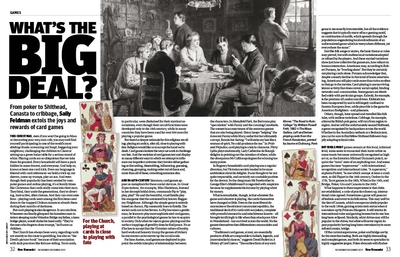 This Christmas, even if you won’t be going to Mass or decorating your very own crib, you may well find yourself participating in one of the world’s most abiding rituals: screaming out Snap!, beggaring your neighbour, challenging the children to Cheat or setting up a green baize table for a serious round of whist. Playing cards are so ubiquitous that we take them for granted. Every household will have a pack hidden in some drawer, and everyone, God help us, knows at least one card trick. Even our language is littered with card references: we hold a trick up our sleeves, come up trumps, play an ace. And even though their popularity has been eroded by computer games and online playing, it’s at family times like Christmas that cards really come into their own. They bind, they unite the generations, they’re diverting, instructive, often riotous. And they can even save lives – playing cards were among the first items sent down to the trapped Chilean miners to absorb them during their months of darkness.
This Christmas, even if you won’t be going to Mass or decorating your very own crib, you may well find yourself participating in one of the world’s most abiding rituals: screaming out Snap!, beggaring your neighbour, challenging the children to Cheat or setting up a green baize table for a serious round of whist. Playing cards are so ubiquitous that we take them for granted. Every household will have a pack hidden in some drawer, and everyone, God help us, knows at least one card trick. Even our language is littered with card references: we hold a trick up our sleeves, come up trumps, play an ace. And even though their popularity has been eroded by computer games and online playing, it’s at family times like Christmas that cards really come into their own. They bind, they unite the generations, they’re diverting, instructive, often riotous. And they can even save lives – playing cards were among the first items sent down to the trapped Chilean miners to absorb them during their months of darkness.
But card-playing is also dangerous. It can ruin lives. Whenever our family glimpsed the homeless men in tatters sleeping under Waterloo Bridge my father, a keen bridge player, would shake his head sadly. “They’re the ones who forgot to draw trumps,” he’d warn us children.
The Church has always been wary, regarding cards not merely as the route to gambling, but also as “the Devil’s picture-book” because of their association with dark practices like fortune-telling. Tarot cards, in particular, were disdained for their mystical associations, even though their occult functions were developed only in the 18th century, while in many countries they have been used for over 500 years for playing a popular game.
But there’s a deeper rationale for this religious recoiling: playing at cards is, after all, close to playing with fate. Religion would like us to accept the hand we’re dealt. Card games imitate the ways we work to challenge our fate. And the varieties of card games test and display so many different ways in which we attempt to influence our imperfect universe: they involve either gathering or discarding, dissembling, influencing, guessing, chancing, grouping, making order out of chaos and, more than all of these, outwitting someone else.
And in 19th-century literature, card games appear as metaphors for these social devices. In Great Expectations, for example, Miss Havisham, dressed in her decrepit bridal dress, commands Pip to “play, play, play!” He and the beautiful, cruel Estella play the one game that the untutored boy knows: Beggar-my-Neighbour. Although the simple game is entirely based on chance, Pip constantly loses to Estella. The social cards are in her favour. As Pip becomes a gentleman, he learns to play more sophisticated card games, a parallel to the psychological games he has to acquire in society. Only when he rejects game-playing and the surface trappings of gentility does he find peace. It’s as if he has to accept that the Victorian values of loyalty, hard work and honesty trump the games of trickery he encounters as he moves up the social scale.
For Jane Austen, card games are deployed to pinpoint the subtle interplay of relationships between the characters. In Mansfield Park, the Bertrams play “speculation” with Fanny and the cunning Crawfords. The contest is an enactment of the amorous games that are also being played. Henry keeps “helping” the innocent Fanny while Mary, seductive but ultimately corrupt, flaunts her daring: “I will stake my last like a woman of spirit. No cold prudence for me.” In Pride and Prejudice, card playing is a key to character. Flirty Lydia plays exuberantly, Lady Catherine de Bourgh delights in pointing out the mistakes of others, while the obsequious Mr Collins apologises for winning too many points.
In Regency households card-playing was a regular diversion, but Victorian society tended to be more ambivalent about its delights. It was thought to be not quite respectable, and certainly not a suitable pastime for the devout. So the clergyman Mr Farebrother in George Eliot’s Middlemarch is regarded with suspicion because he supplements his income by playing whist for money.
What is remarkable, though, is that whatever the game and whoever is playing, the cards themselves have changed so little. Even in the most liberal democracies or the strictest communist republics, the traditional deck of 52 cards with two jokers, complete with powerful monarchs and mischievous knaves – all brought terrifyingly to life when they attack poor Alice in Wonderland – has survived across the world. It’s the games themselves that differentiate communities and cultures.
“Traditional card games, at root, are essentially products of folk art comparable to ballads, legends, and (more similarly) dances,” suggests David Parlett in A History of Card Games. “The earliest form of any such game is necessarily irrecoverable, but all the evidence suggests that it typically starts off as a gaming motif, or combination of motifs, which spreads through the populations engendering local embodiments of an unformulated game which is ‘everywhere different, yet everywhere the same’.’’
Just like folk songs or stories, the basic theme or rules may prevail, but with endless local variations adopted or refined by the players. And these myriad variations show just how collective the games are, how reliant on human interaction. Americans may, according to Robert Putnam, be “bowling alone”. But they’re certainly not playing cards alone. Putnam acknowledges that, despite a steady decline in this kind of home entertaining, Americans still play cards more than twice as often as they go to the movies. Card-playing is one surviving leisure activity that does convey social capital, binding networks and communities. Some games are identified solely with particular groups. Kalooki, for example, is the province of London taxi drivers. Klobiosh has been transported by and is still largely confined to Eastern European Jews, while pinochle is the game for American firefighters – and prisoners.
Others, though, have spread and travelled like folk tales, with endless variations. Cribbage, for example, a favourite British pub game, will vary from region to region. And so will the unfortunately named Shithead, a game recognised by backpackers across the world. Whether in the Australian outback or a Bedouin tent, you can be sure to find fellow Shithead followers happily adapting to local rules.
But while most games remain at this local, informal level, some seem to transcend their roots rather as some music becomes universally recognised as high art or, as the historian Michael Dummett puts it, acquire the “nova” state of an exploding star. And some games become “supernovae” – with international recognition and international rules. “A supernova,” explains Parlett, “is one which sweeps at least a continent, as did Piquet in the 16th century, Ombre in the 17th, Tarot games in the 18th, Whist in the 19th, and Bridge, Poker, Gin and Canasta in the 20th.”
What happens to these supernovae is that clubs are established, a code of practice drawn up, international rules agreed. Sometimes a game will pass out of fashion and revert to its folk status. This may well be the fate of Canasta, which was spectacularly popular in the early 1950s, gaining aristocratic status when it was taken up by Princess Margaret. It still retains its international rules and gaming houses but its star has long been eclipsed. Similarly, whist drives may still be popular in the shires, but whist will never regain its past popularity having long been overtaken by its more refined cousin, bridge.
Of the current supernovae, poker and bridge are by far the most fascinating. Both are highly demanding and complex games, and both do seem to specialise in highly suggestive jargon. Poker abounds with flushes and straights, while in bridge there are rubbers, jump take-outs and slams. But there are vast differences between them. Poker, which at its most sophisticated involves a mixture of memory, psychology, statistics, bluffing and daring, is probably the most classless of card games, appearing everywhere from the world’s most exclusive casinos to the most modest back rooms. You’ll find poker addicts among manual workers and novelists, crooks and bishops. Despite its massive incursion online, people of all classes still play in groups, among friends, in clubs.
And Poker, somehow, has all the attributes of style and cool. There’s probably more poker in the movies than any other game or sport. In the heyday of the western, every saloon would feature a gaming room where the sharpest-shooting heroes and wiliest of black-hatted villains would fight out an indoor version of the OK Corral. More recent movies have picked up on the appeal of the western. Mel Gibson, for example, plays a latter-day Maverick, stepping into James Garner’s leather boots as the greatest card sharp of them all in a comic homage to the original.
You can’t really get classier than James Bond, and in Casino Royale Daniel Craig demonstrates that good spies have to be good bluffers on top of everything else. The Texas hold ’em game – a version of poker – is central to the film, which is located, naturally, in a fabulously lush casino with Craig in evening suit, surrounded by extravagantly attired sexy women.
At the other end of the spectrum, though, poker is a symbol of the great American dream, whereby even the poorest, the most disadvantaged, can rise to the top. That’s the theme of The Cincinnati Kid, set in the Depression era, with a determined Steve McQueen taking on the rich and powerful with wit and cunning. And probably the most telling of all poker movies is Robert Altman’s California Split, with George Segal and Elliott Gould pairing up to hit the casinos and the backroom poker rooms in a homage to gambling where chance itself becomes the only reality.
In comparison, bridge has none of the glamour of poker. It doesn’t feature in casinos nor in movies. Far from the worlds of crooks or adventurers, bridge is more associated with gouty colonels and genteel suburban parties. Agatha Christie’s characters play bridge; Chandler’s play poker. Nonetheless, bridge has the status of being the most challenging, the most intellectual and the most internationally competed of games. And it also has the distinction of being the only card game where luck and chance are eliminated.
In duplicate bridge, couples will play not just against their immediate opponents, but against other couples in the set who are dealt the same cards. So what matters is not the strength of the hand, but how skilfully it is played. And that is the theme of Louis Sachar’s latest book for teenagers. 17-year-old Alton, the narrator of The Cardturner, is hired by his irascible, blind uncle to accompany him to his bridge club to turn the cards and recite what is in his hand. As the relationship develops, so does Alton’s interest in the game, which acts as a neat device for him to contemplate the difference between what is real and what is perceived, to what extent you really can eliminate the unknown, or chance, or luck.
Sachar’s clear intention is to revive interest in the game he loves, so that the novel also acts as an instruction manual on how to play. “Unfortunately,” he writes, “not too many people play anymore, especially not young people.” And Robert Putnam would agree. Not only is the number of people playing cards declining; the decrease in bridge-playing seems to be terminal. “In the late 1950s, it was estimated that 35 million Americans – nearly one third of all adults – were bridge players,” he reports. But by 1999 “the average age of members of the American Contract Bridge League was 64 and rising steadily, a sure sign that the decline is generational in nature . . . A growing fraction of all card games occurs in retirement communities, the sociological equivalent of isolated ecological niches where endangered species often make a last stand.”
Putnam also points out that although bridge, like poker, does attract internet players, the nature of the game online is entirely different. Participants are focused totally on the game, with no social interaction or any interest in their faceless adversaries. And this is a sad loss – the disappearance of an activity that, at its core, is both human and humanist.
So when you get out that faded pack this Christmas and start to deal to family and friends, be comforted that you’re actually keeping alive a humanist tradition. And if that doesn’t appeal to you, why not dig out our sacrilegious free gift and indulge in a rip-roaring round of God Trumps?
The Cardturner by Louis Sachar (Bloomsbury) and A History of Card Games by David Parlett (Oxford University Press) are out now

